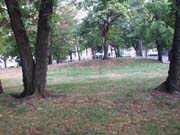More than 50 residents of the Summit Avenue and Astor Place area gathered Wednesday night to listen to a developer’s plans for moderate-income housing in their neighborhood.
The plans may go before the city’s Planning Board in September.
While all present agreed moderate housing was needed in the section noted for prostitution and drug dealing, issues of greenspace preservation and a community notification were raised.
According to developer David Barry of Applied Housing, who spoke at the meeting, 52 Summit Ave. is the proposed location for 46 units of moderate income housing, built in what he described as the townhouse style.
There will be 23 separate buildings. Each building will have two units: a three-bedroom unit on one side and a two-bedroom unit on the other. Each building also will have a driveway.
"These will all be for sale," Barry said. "None of them will be rental. They will be marketed primarily to people from Jersey City."
Barry described moderate-income for a two-bedroom section as being $44,000 a year combined income per family, and $52,000 a year for the three-bedroom sections. Prices on the three-bedrooms will be $111,000, and prices on the two-bedroom portions will be $94,000.
It was unclear last week if all of the units would be moderate-income, and whether some would be low income. The project is eligible for a $1 million state grant for construction, which would mean 10 percent of the development will have to be low-income housing.
Possible opposition
Mary McLean, president of the Astor Place Residents Association, first heard in March that Applied Housing was looking at a number of locations in Jersey City for possible moderate income housing development, including 52 Summit Ave.
"Last week we were contacted and found out they were looking at the lot," said McLean. "I told them they would be facing serious opposition."
McLean said she wanted to see a comprehensive approach to developing the area, taking into account the need for green space and the possible increase of traffic on Summit Avenue.
"The city needs to work with the community to see what the community needs," McLean stated. "There does not seem to be a plan for what is to be built."
In response to residents’ objections on the issue of green space preservation, Barry said he altered his original plans and removed six units from the area where Summit and Cornelison Avenues join, leaving the area open. Barry added he could relocate the six units to the ravine that faces Cornelison where the other units would be built.
However, Barry said a "D" variance would be required to build in the ravine since it is zoned for light industrial use.
Peter Burmeister of 64 Summit Ave. stressed the historical significance of the lot, noting Summit Avenue was, in early colonial times, an Indian trail.
"There was a large Victorian mansion here during the 1800s," said Burmeister.
Area historian Dennis Doran stated the mansion was the residence of the Dickinson-McBurney family, Jersey City lawyers and businessmen who lived on Summit Avenue in the late 1880s. The mansion was likely torn down at the beginning of the 20th century.
Speaking at the meeting, Jersey City Mayor Glenn Cunningham said the ravine had been a stopping point for black slaves on the run in colonial New Jersey.
Noting the ground under 52 Summit Ave. was comprised of trap rock, a hard igneous rock caused by volcanic eruptions, Burmeister asked Barry if any blasting would have to be done before construction began. Burmeister was concerned about structural damage to nearby buildings, which he owns, from the shock of blasting.
Barry replied that he did not anticipate any blasting would be needed, but added core samples would be gathered for testing in the next two weeks.
"This was a very positive meeting," said McLean after the developer spoke. "A lot of issues we wanted to know about were addressed."
